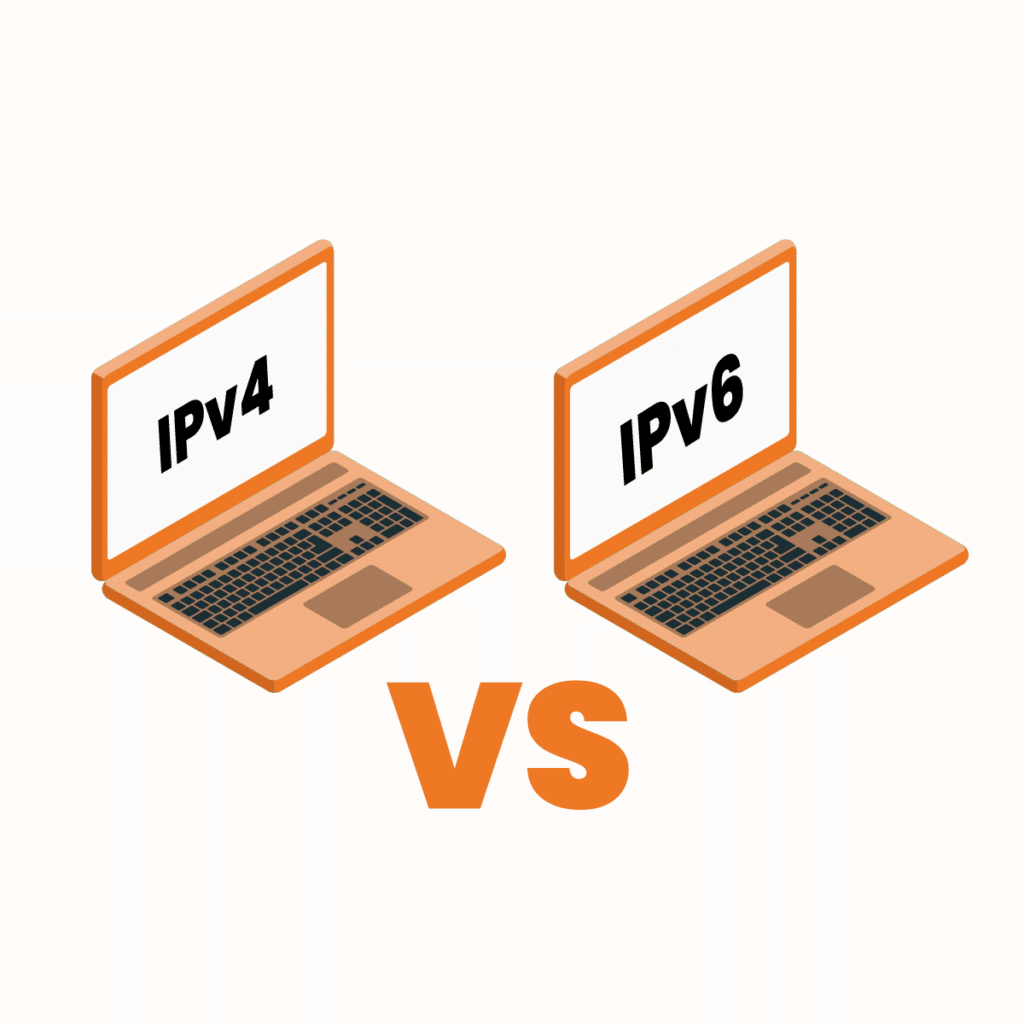We are all used to sending and receiving information and data over the internet with our smartphones, computers, and other communication devices. But do we know how our devices process and send these pieces of information?
Well, this IPv4 vs IPv6 guide will show you all you need to know about the behind-the-scenes while sending and receiving data over the internet. For starters, when you send anything over the internet, it is broken down into bits of packages, usually referred to as data packets. Internet Protocols (IP) are used to rearrange these pieces of data and show them where to go.
That’s how important an IPv4 vs IPv6 comparison is.
There are two major kinds of IP addresses. This IPv4 vs IPv6 article will focus on explaining and differentiating both of them.
IPv4 vs IPv6: A Brief Overview of IP Addresses
As previously hinted in this IPv4 vs IPv6 guide, an IP stands for Internet Protocol, and it is a set of guidelines that guides how packets of data are moved through the web to their respective destination. In other words, an IP is simply the address through which two computers can interact and exchange data between each other. For instance, if you want to retrieve information or a file from a website, you will need the address of that site. This address is called an Internet Protocol Address.
An IP address is a string of numbers separated by periods and is designated to a device or domain that is connected to the internet. It has different formats or types depending on the version of the network or device’s internet protocol. We will explore further the meaning and differences between ipv4 vs ipv6 in this article.
What is IPv4?
As we progress in this IPv4 vs IPv6 article, we will define some terms. IPv4 stands for Internet Protocol Version 4 and is the first version of Internet protocol to be popularised in the late 1980s.
The IPv4 is an IP that has a set of 11 digits separated by periods. This grouping can also be referred to as dotted hexadecimal notation.
This is what an IPv4 address looks like: 192.168.12.123
Every number in the address carries information that specifies the destination of data packets. Each group or set of numbers stores one byte of data, and an IPv4 address contains four groups, which sums up to 32 bits in overall data storage. This is why the IPv4 system is often referred to as a 32-bit addressing system.
The IPv4 address is made up of two sections containing the network IP address and the host IP address.
The IPv4 system can support about 4.29 billion unique addresses. This figure may sound huge to you until you realize that a vast number of people are connected and using the internet daily. With the rise of the Internet of Things (IoT), these smart devices also need and use IP addresses to communicate. With the explosion and integration of technology and smart devices all over the world, the IPv4 system may be unable to cater to such huge demands. Imagine the new devices that consistently flood the market daily. We will soon run out of IP addresses if we only rely on IPv4.
Features of IPv4
This IPv4 vs IPv6 section will explore the features of IPv4.
The IPv4 addressing system was developed in 1978, and it standardized the way devices and computers interacted with each other over the Internet. The IPv4 is connectionless, meaning you can send out data with it even though the receiving parties don’t establish a direct connection. It also uses only a small portion of memory.
Some core features of the IPv4 protocol are
- IPv4 offers support for video libraries and seminars.
- It helps you easily create an online communication architecture over diversified devices.
- It is supported by millions of computers and internet-enabled devices
- It requires little memory and can easily recall addresses.
What is IPv6?
As we delve deeper into the IPv4 vs IPv6 comparison, let’s understand what an IPv6 is.
The IPv6 protocol is an offshoot of the IPv4. It was developed in December 1995 by the Internet Engineering Task Force (IETF). The IPv6 stands for Internet Protocol Version 6 and is the newest version of Internet Protocol. The IPv6 is far better than its predecessor in that it can efficiently handle complex systems and, of course, can contain more IP addresses.
IPv6 is a group of 8 hexadecimal digits differentiation with colons. It is the latest standard for identifying devices and computers on the internet. It works exactly like IPv4 in giving every computer or device a unique identifier. However, the icing on the cake here in this IPv4 vs IPv6 guide, is that the IPv6 has been adjusted to cater to the ever-increasing demand and number of computers and smart devices connected to the internet.
What this means is that, whereas we previously had only around 4.3 billion unique identifiers for each device and computer on the planet, IPv6 takes that number to an insane 340 trillion trillion trillion addresses.
The IPv6 addressing system uses a 128-bit hexadecimal digit system. This means an IPv6 address would look like this:
2001:0ab5:67a3:0000:0000:6a3e:0333:4445
The IPv6 system has been streamlined to remain in sync with most of today’s modernized proxy-driven internet. Thereby getting rid of outdated or unnecessary components of the old IPv4 system. We will consider some of these further in this IPv4 vs IPv6 article.
Features of IPv6
IPv6 makes data run efficiently by restoring direct communication between any two devices. This is something IPv4 could not do, but had to come up with additional procedures to compensate for the lack of unique IP addresses.
With IPv6, data packets do not need to be reviewed first to ensure what was received was what was sent, for instance, as is the practice under a connectionless system.
IPv6 has made data movement efficient, among other things listed already in this IPv4 vs IPv6 guide.
- IPv6 has support for Quality of Service (QoS)
- It is great for neighboring node communication
- IPv6 is both a stateless and stateful configuration
- It has a hierarchical addressing system and routing infrastructure.
Benefits of IPv6
These are some of the benefits of IPv6.
- Improved Security: This IP version comes with some inbuilt security measures, some of which are Data Encryption, Data Authentication, etc. An internet connection over IPv6 is more secure than its counterpart.
- Prioritize: As mentioned previously in this IPv4 vs IPv6 article, IPv6 has stronger and more dependable QoS-supportive features. These features help in boosting traffic over websites and video and audio quality on webpages.
- More Address Space: This is perhaps the most important benefit of IPv6. It has 128-bit address space, which is larger than IPv4’s 32-bit.
- Simplified Header: IPv6’s header is simpler when compared to that of IPv4. This makes it faster in internet connectivity and also more cost-effective.
- Better Support for Mobile Devices: The IPv6 addressing system has better and increased support for mobile devices. It provides quicker interactions with other mobile devices and proxies in a healthy way than IPv4.
IPv4 vs IPv6: Why Do We Need Two IP Versions?
As you must have already picked up by now in this IPv4 vs IPv6 comparison, the IPv6 became needed due to the limitations of IPv4.
For clarity’s sake, let’s go ahead in this IPv4 vs IPv6 guide to discuss briefly why we ever needed two IP versions.
Firstly, the main purpose of a second IP was due to the expansivity of the internet.
Both IP addressing systems have different structures. The IPv4 only supports numbers 0 to 9, while IPv6 goes beyond that to letters “a to f.” As a new bit is added, the address space doubles in size. This means we can create more IP addresses with IPv4 vs IPv6. While the former is just around 4 billion, the latter can contain up to 340 undecillion addresses. That’s an astonishing number of unique addresses.
To put this in perspective in this IPv4 vs IPv6 guide, imagine every individual on the planet has a single internet-enabled device. This means several billions of devices and people won’t be able to access the internet simultaneously in an IPv4 world.
Although governing bodies place restrictions on how many IP addresses are created and made available for the public, there are still more IPv6 addresses than IPv4.
At this time, anyone who thinks we would run out of them will look really weird.
Although the world is moving quickly toward the IPv6 protocol, much of IPv4 is still in use. While top content platforms like Netflix and Facebook use IPv6, Alexa reveals that only 19.1% of its top ten million websites use the protocol. This shows that the journey to a full-fledged adaptation of the IPv6 protocol is still a far cry.
IPv4 vs IPv6: Their Differences
The format of their addresses and address space are the major differences between an IPv4 vs IPv6 addressing system. Also, things like inbuilt security features, support for efficient routing, and enhanced network auto-configuration make IPv6 a more advanced and safe protocol.
So far in this IPv4 vs IPv6 guide, you are already well-informed about the details of these protocols. Let’s closely consider their differences using the table below.
| IPv4 | IPv6 | |
| Number of header spaces | 12. | 8. |
| Address size | 32-bit addressing system | 128-bit addressing system |
| Header field length | 20 bytes | 40 bytes |
| Addresses type | Multicast, broadcast, and unicast | Multicast, anycast, and unicast |
| Addressing method | IPv4 system is number-based | IPv6 is alphanumeric |
| Checksum fields | Present. | Absent. |
| Configuration | For IPv4 to interact with other systems, the new systems must be installed and configured | Here, configuration is optional. |
| Number of classes | There are five different classes. Starting from A to E | Has an unlimited number of addresses. |
| Network configuration | Manual configuration or via DHCP – dynamic host configuration protocol. | Comes with an auto-configuration capability. |
| Routing information protocol (RIP) | IPv4 has support for RIPv1 and RIPv2 | Supported by RIPng |
| Virtual length subnet mask support (VLSM) | IPv4 supports VLSM | IPv6 doesn’t support VLSM |
| Address mask | IPv4 uses address masking for the designated network from the host segment | Does not use address masking |
| Features of Address | Uses NAT (Network Address Translation), letting a single NAT address depict thousands of non-routable IP addresses. | IPv6 supports direct addressing due to its huge space of IP addresses |
| Address configuration | Via DHCP or manually | IPv6 uses a stateless address automatic setup using the ICMPv6 or DHCPv6 |
| Packet size | Minimum packet size of 576 bytes | Minimum packet size of 1208 bytes |
| Packet fragmentation | This is done by forwarding and sender routers | This is done by the sender routers alone |
| Packet header | IPv4 does not support quality of service handling packet flow identification, including checksum options. | IPv6 supports and specifies flow label fields of quality of Service Handling packet flow |
| SNMP | IPv4 supports SNMP | Does not support SNMP |
| Interoperability and mobility | IPv4 uses constrained network topologies that restrict interoperability and mobility capabilities. | Provides full interoperability and mobility capabilities. |
IPv4 vs IPv6: Comparison
In this section of this IPv4 vs IPv6 guide, we will compare the two internet protocols over several factors. Some of these factors have already been hinted at in several places in this IPv4 vs IPv6 article, but we will try to delve deeper into how they both compare and contrast.
IPv4 vs IPv6: Security
In terms of security, IPv6 leads the way. It comes with IPSec (IP Security). The IPSec is a set of protocols that secure communications between networks at the IP layer. It has three constituents that provide security to different parts of network communications.
- Internet Security Association and Key Management Protocol (ISAKMP): This component describes the security features that two devices use to share data.
- Authentication Headers (AH): This helps the network to verify and authenticate the source of a data packet and if the transmission has changed. They also stop hackers from developing fake data packets to smuggle malware into a software, application, or device.
- Encapsulating Security Payloads (ESP): This component adds another layer of verification to safeguard the data transmission.
Yes, indeed, a good IPv4 vs IPv6 guide will mention that although IPv4 can also use IPSec, its usage depends on the end-users and network providers. Also, the IPSec framework does not work with NAT-based connectivity.
Furthermore, in this IPv4 vs IPv6 security comparison, IPv6 trumps IPv4 because the former can handle integrity-checking and end-to-end encryption. This attribute makes attacks against networks, such as man-in-the-middle breach, more difficult to carry out.
Under the security of IPv4 vs IPv6, the latter uses the SEND (Secure Neighbour Discovery) protocol. This protocol offers a more secure name resolution. The result? Hackers won’t find it easy to redirect traffic between two real hosts and manipulate or observe their interactions.
Overall, IPv6 offers a more robust security measure than IPv4. However, these security features depend strictly on accurate design and implementation.
Just a tip: Ensure you activate a firewall, antivirus software, and access control system whether you use IPv4 or IPv6.
IPv4 vs IPv6: Speed
In the course of finding out which is better, between IPv4 vs IPv6, a series of tests were conducted by Sucuri on websites that support IPv6 and IPv4. They discovered that they both had the same speed in direct connections.
Notwithstanding, several other IPv4 vs IPv6 tests show that IPv6 has better speed than IPv4. One of such tests is the Akamai’s study. This IPv4 vs IPv6 study showed that the performance improvement in the top four mobile networks in the United States favored IPv6 over IPv4.
Another IPv4 vs IPv6 test that places IPv6 over IPv4 is the Facebook Engineering test, which revealed that accessing the platform over an IPv6 network is about 10 to 15% faster than IPv4.
IPv4 vs IPv6: Internet of Things
Let’s discuss how the IPv4 vs IPv6 comparison affects IoT.
Besides the structural differences between the two protocols and also meeting users’ needs, the IPv6 addressing system plays a great role in the implementation of the Internet of Things (IoT), especially since its complex and advanced nature and a large amount of address space is a big plus for future industry developments.
IPv4 vs IPv6 statistics show that the total number of IoT-enabled devices in the world is predicted to reach a whopping 43 billion. As you might already know in this IPv4 vs IPv6 guide, the IPv4 system cannot cater to such a huge number of emerging devices.
Several IPv4 vs IPv6 articles have shown that the Internet of Things is rumored to be one of the foremost essential IPv6 adoptions of the century. With an ever-increasing demand for smart devices and interconnectivity, the number of devices is being doubled and tripled daily, making the number of IP addresses needed to run into their trillions, and IPv6 is better positioned to help facilitate such huge advancement in the IoT ecosystem as already hinted in this IPv4 vs IPv6 guide.
IPv4 vs IPv6: Address
The IPv6 address is made up of alphanumeric characters separated by colons (:). The characters range from 0 to 9 and a to f.
The IPv4 addresses are only made up of numbers ranging from 0 to 9 and are separated by periods. They are made up of 32-bits.
IPv4 can only manage up to 4.3 billion addresses, while IPv6 can hold 340,282,366,920,938,463,463,374,607,431,768,211,456 addresses making it better for future integrations and developments.
IPv4 vs IPv6: Header
IPv4 header address is more complex than IPv6. IPv4 has 12 header fields, but IPv6 simplifies its fields and makes it optional, offering only eight header fields. You can use these not-too-popular headers in an extension of IPv6 headers. The limited number of IPv6 headers makes it much easier to process as much bandwidth is reduced.
If you are using IPv4, then six fields must be processed by an intermediate router. However, with IPv6, you only need four. This improves the efficiency of forwarding IPv6 data packets.
Although the IPv6 headers are less than the IPv4 headers, the former still contains destination and source addresses that are often four times lengthier than IPv4 headers, that is, 128bits vs 32bits. This often makes the IPv6 headers weightier.
IPv4 vs IPv6: Addressing and Routing Efficiency
The IPv6 was designed to create an efficient, summarized, and hierarchical routing infrastructure. This infrastructure is based on the common occurrence of several layers of Internet Service Providers. This infrastructure helps it decrease the amount of routing of backbone routers. This can offer an efficient internet experience.
IPv4 vs IPv6: Which Should You Use?
From all that has been discussed so far in this IPv4 vs IPv6 guide, the question of whether to use IPv4 or IPv6 is not a difficult one.
Some IPv4 vs IPv6 comparison enthusiasts believe IPv6 is still in its cradle stage and, hence, is prone to several loopholes and attacks that can mar users. Others claim that IPv6 is reliable and offers better and more advanced functionality.
Since the underlying reason for developing IPv6 is primarily to cater to the increasing demand for devices and technological applications, it is safe to say that if IPv4 addresses are still available for use, then they offer a more sturdy and community-based system than the newer IPv6.
However, when we run out of available IPv4 addresses, everyone will be forced to move to IPv6 and build it to become as sturdy and efficient as IPv4, and the IPv4 vs IPv6 debate would have ended.
IPv4 vs IPv6: What Does The Future Hold for IPv4?
As of today, we have only a few IPv4 addresses available. This is why the IPv4 vs IPv6 debate is quite unnecessary.
RIPE NNC, a part of the RIRs (Regional Internet Registries), has previously announced that they had run out of IPv4 addresses.
Despite these claims, the IPv4 addressing system will still be in use for a while, and these are our reasons for saying so.
- Lack of Compatibility: Most older devices and applications are not compatible yet with the new IPv6. Using it regardless might throw in some DNS error messages.
- NAT Usage: This is a technology that extends IPv4 protocol addresses, letting users distribute a single IPv4 address across thousands of computers and devices at an affordable rate.
- Replacing IPv4 devices is costly: The time and cost it will take to upgrade IPv4-enabled devices to IPv6 fully may make many stick with the old gun.
- Most network operators use the “wait and see” method: As mentioned above, running IPv4 and IPv6 is expensive, and upgrading equipment is also time-consuming. This might make many network operators keep using IPv4 until more operators start using IPv6.
- Yes, IPv4 addresses can be sold and re-used: Some companies that need IPv4 addresses are still able to buy them from IP address vendors.
IPv4 vs IPv6: Adapting IPv6
Let’s address some of the IPv4 vs IPv6 issues raised above.
While it may look easier to remain with IPv4 because of the reasons stated above, the rise in the demand and supply of IPv4 might drive the prices high.
Secondly, using NAT is not sustainable in the long run. This is because NAT was initially developed as a temporary technology. This means it may not function properly with all protocols and applications.
So, eventually, IPv6 is still the ultimate solution to all these issues.
And, what’s more? The transition from IPv4 to IPv6 is already in motion. Google already states that 40% of all internet-enabled devices worldwide use IPv6.
As more mobile carriers, internet service providers, and large manufacturing companies and enterprises adopt IPv6, this will increase the overall number of websites, software, and equipment that use IPv6. Although the migration process may be slow, in years to come, the pace may become faster than this.
IPv4 vs IPv6: Frequently Asked Questions
How Much IPv6 is in Use Today?
IPv4 has been around the scene for a long time, so it is normal for it to have more users than the new IPv6. However, the adoption of IPv6 is advancing steadily as IPv4 addresses run out. Google estimates that about 50% of the US has adopted IPv6, Australia 29%, Argentina 18.4%, and Sweden 19%.
IPv4 vs IPv6, Which is Faster?
The short answer would be IPv6. However, sometimes, the IPv6 address does not seem to be much faster than the old IPv4 addresses. Sucuri, a cloud-based company, tested the two addresses against each other in different scenarios, and there wasn’t much difference in their speed.
There are also other cases where IPv6 proved to be faster than IPv4. For instance, Facebook’s test showed that IPv6 websites loaded 12% faster than IPv4.
Can I Turn off IPv6?
Yes. You can turn off IPv6 on macOS, Windows, and Linux. However, this might cause some functions to stop working. The more the demand for IPv6, the more your computer will need IPv6 resources and proxies.
IPv4 vs IPv6: Conclusion
Computers and devices use the internet protocol to send and receive data packets and information over the internet. There are only two IP address versions that exist today: the IPv4 and the IPv6.
IPv4 vs IPv6 comparison sees the IPv6 having more address space, speed, and better security measures than the IPv4. This has made the former a future choice for IP address adaptation.
To ensure you are well-informed on other related topics like proxies and their role, read our blog. We hope this IPv4 vs IPv6 blog has exposed you to the meaning and differences between these two IP addresses.





